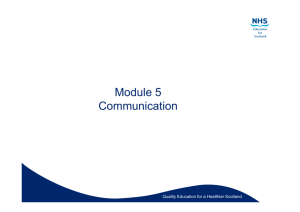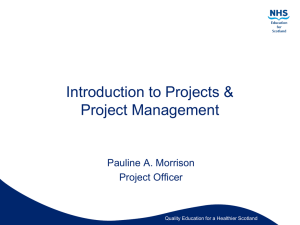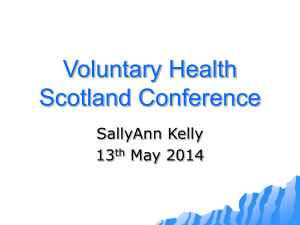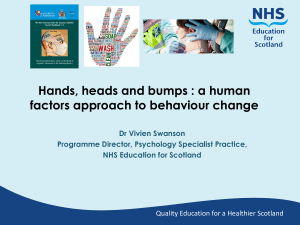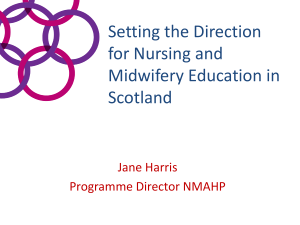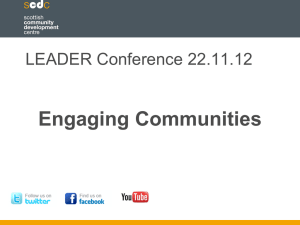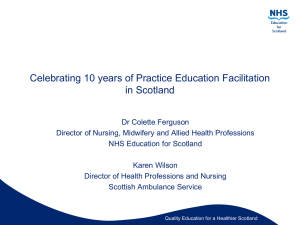Finding Common Ground - Clinical Skills Managed Educational
advertisement
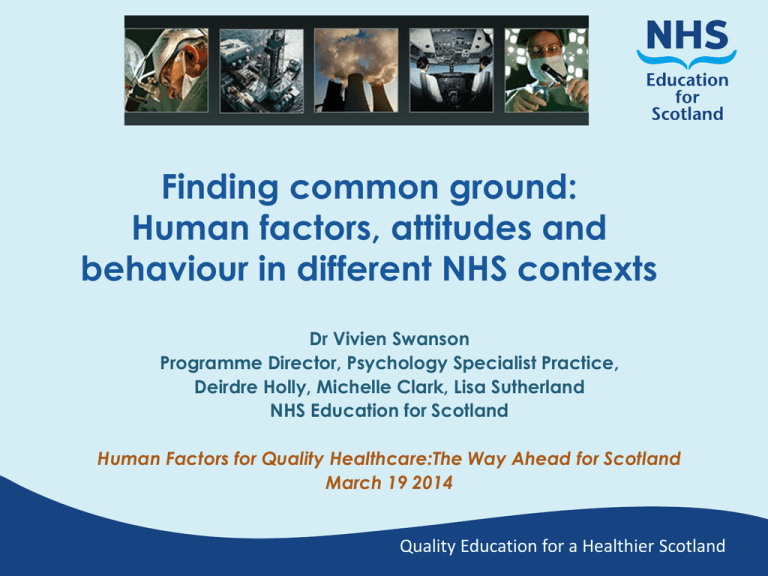
Finding common ground: Human factors, attitudes and behaviour in different NHS contexts Dr Vivien Swanson Programme Director, Psychology Specialist Practice, Deirdre Holly, Michelle Clark, Lisa Sutherland NHS Education for Scotland Human Factors for Quality Healthcare:The Way Ahead for Scotland March 19 2014 Quality Education for a Healthier Scotland AIMS • Extend previous Human Factors (Non-technical skills) work (mainly surgical, hospital-based) to other NHS Scotland contexts • Using psychology, behaviour change theory to develop and evaluate interventions • Understand differences in Human Factors related to context • Develop a basis for future curricula for patient safety training Quality Education for a Healthier Scotland HUMAN FACTORS… Enhancing clinical performance through an understanding of the effects of teamwork, tasks, equipment, workspace, culture and organisation on human behaviour and abilities and application of that knowledge in clinical settings” (Catchpole 2010) Quality Education for a Healthier Scotland Five studies : Five contexts: Five sets of HF behaviours? • BASICS – remote and rural resuscitation training • SHINE – eSEA reporting in primary care • MUS – reducing GPs secondary care referrals to improve patient care • MHPSP – human factors in restraint mental health in-patients • TRAINEE hospital doctors and hand hygiene Quality Education for a Healthier Scotland Commonalities – human factors individual/team-based • Common Human factors Including………. Personal : Cognitive, mental load, stress and fatigue Team : Communication, decision making, teamwork Context: Situational awareness, information gathering Quality Education for a Healthier Scotland Commonalities: Using behavioural theory,(TPB) • • • • • • • • Attitudes Norms Self-efficacy Intentions The intentionbehaviour gap? Patey, Flin et al. WHO Patient Safety Curriculum Guide for Medical Schools: Implementation Study (2010) Wakefield et al, 2010 Health professionals patient safety behaviour ; Jenner et al. 2002. Explaining hand hygiene practice. Psychol health and med. Quality Education for a Healthier Scotland TPB: Positive attitudes, norms and confidence predict intentions (BASICS, MUS, HH) ATTITUDES Perceived importance of communication during resuscitation (BASICS) SOCIAL NORMS Other doctors encourage me to refer (patient) for investigations (MEDICALLY UNEXPLAINED SYMPTOMS) CONFIDENCE Its easy for me to wash my hands before and after patient contact (HAND HYGIENE) Quality Education for a Healthier Scotland Intention-behaviour gap… “And I was trying to do several things at once. And I did not do that very well. And certainly that is one thing when I thought about hand hygiene at the end of it that just went out the window. It basically never entered my head even though I had spent so long before that point washing my hands every time I went into a room, every time I left a room” (HH) Quality Education for a Healthier Scotland And differences… • Health professionals : – Level of experience, seniority • Control (responsibility): – Individual, group, system • Task : demands – Frequency, (Routine, habit, one-off), implications, cognitive complexity • Context: – Time, resources Quality Education for a Healthier Scotland Quality Education for a Healthier Scotland BASICS : Mapping human factors onto BCTs (Motivation, Action, Prompts) Elements Human factors Behaviour change technique Planning, preparing Prioritizing Coping with pressure Goal setting (A1) Time management (A19) Coping strategies (M14) Team working Co-ordinating activities Exchanging information Supporting others Social support (M12) Social skills training (A27) Situation awareness Gathering information Recognizing, understanding Projecting, anticipating Self-monitoring of behaviour (A3) Antecedents and consequences (A4) Coping strategies (M14) Decision-making Identifying/considering options Balancing risks, options Implementing & reviewing Goal review (A10) General problem solving (A22) Assertion training (M18) Leadership Setting, maintaining standards Supporting others Coping with pressure Goal setting (A1) Feedback (A5) Assertion training (M18) Communication Exchanging information Shared understanding Acting assertively Information about behaviour (M10) Graded tasks (A11) Behavioural rehearsal (P11) Task management Quality Education for a Healthier Scotland Recommendations : Generic and specific behaviour change techniques • Further work to develop and evaluate training in Human Factors – Use taxonomy to MAP BCTs onto generic and specific human factors – Test in different groups of health professionals – For both novice and experienced groups • Develop a curriculum for the service with standards (levels of competence) which could be assessed with both generic and specific elements Quality Education for a Healthier Scotland “Without this, human factors will be considered as a generic competence and fail to receive the attention that it rightly deserves or indeed be appreciated for what it is - a way to secure high standards of care, performance improvement as well as minimise risk and harm to patients.” Professor George Youngson Quality Education for a Healthier Scotland
